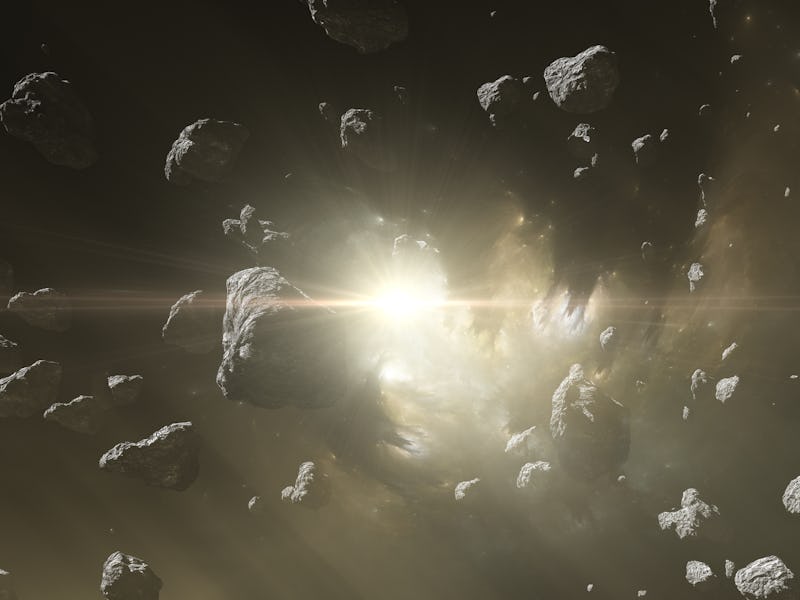Scientists find two key ingredients for life in ancient meteors
Potassium and zinc were brought to Earth from distant space rocks.

In 1992, an episode of The Simpsons posed an important question to primetime television audiences: what would happen if you lived in a world without zinc? The sequence, a spoof of the 1940 Chevrolet short film A Case of Spring Fever, found narrator Jimmy vexed by the problems of a nightmare world without … zinc.
But zinc is not just useful for car batteries, rotary telephones, and many things made of zinc. According to a pair of new studies published today in Science, the world’s zinc – along with potassium – tells just how the Earth was formed, providing important clues to the environment of the early Solar System, and the ways that other habitable worlds might be formed.
Here’s the background — Long before the Earth formed, the early Solar System’s protoplanetary disk was regularly pelted with gas and dust from other stars, supernovae that, upon exploding, had pushed their own material out into interstellar space. All the matter here on Earth was forged in the hearts of stars, but the material from these other stars does not quite match the material that makes up our Sun; their elements have a different mix of isotopes, known to cosmochemists as nucleosynthetic anomalies.
As Jupiter formed, it divided the swarm of rocks hurtling around the Sun into two groups: the carbonaceous chondrites, cold and volatile-rich meteoroids outside its orbit, and the non-carbonaceous meteoroids, whose volatile elements were boiled away. Despite this, the Earth has plenty of volatile elements, and “we need volatiles for life to emerge,” Rayssa Martins Pimentel, a Ph.D. candidate at Imperial College London and a lead author of the study focusing on isotope anomalies of zinc in meteorites, tells Inverse.
Potassium chloride
What’s new — By looking at the mix of isotopes in carbonaceous chondrites and non-carbonaceous meteorites that have fallen to Earth, cosmochemists are able to determine the different isotopes that are the signatures of the two different herds of space rock. Then by comparing those isotopes to the isotopic signatures of Earth’s zinc and potassium, researchers can determine just how much of the Earth was made up of local non-carbonaceous material and just how much is carbonaceous chondrites that were sent spiraling inward as the Solar System formed.
In both cases, the numbers match — about 90 percent of the material that makes up the Earth was local, but the 10 percent that that came in from the outer Solar System left a mark. They provided 20 percent of our potassium (good news for bananas) and half the world’s zinc.
Zinc and potassium are both especially well-suited to looking back at the Solar System’s earliest days. Potassium is the least volatile of the volatile elements, and thus the one likeliest to not have its isotopes altered by the heat and radiation of the early solar nebula. Its isotopes – potassium-39, potassium-40, and potassium-41 – are either stable or have a half-life of 1.2 billion years.
Zinc, meanwhile, is highly volatile but produced in the final throes of supernovae through the fusion of oxygen and then silicon — the same as iron, calcium, chromium, or titanium, well-studied elements that “we already have very well-characterized anomalies for,” explains Martins Pimentel. Zinc also has an usually high five useable isotopes, “which helps us distinguish between causes of anomalies” — whether local to our Solar System or from some far-away and long-ago supernova.
What the early Solar System might have looked like.
Why it matters — Understanding just where the Earth’s zinc came from helps cosmochemistry understand what the solar nebula — the cloud of gas and dust that eventually collapsed into our Solar System — was like. In a questionnaire, Nicole Nie, a postdoctoral researcher at Caltech and lead author on the paper dealing with potassium, notes that earlier research searching for these kinds of anomalies were limited by available technology.
Not finding evidence of anomalies led earlier cosmochemists to interpret meteorites as evidence that the early Solar System was hot enough to burn away any volatile elements from other stars, homogenizing them. This, she says, “reinforced the idea that the isotopes of volatile elements were well-mixed in the solar nebula.” But this seems not to be the case: anomalous isotopes of volatile elements did survive, and the solar nebula might not have been as well-mixed as assumed.
In addition to telling the story of the earliest days of our own Solar System, Martins Pimentel says this discovery has “consequences for understanding the formation of habitable planets.” If nebulae aren’t as well-mixed as previously thought, then life — bananas to creatures capable of building rotary telephones — needs something to drive “a portion of volatiles to come from the outer system in order to be a habitable planet.”